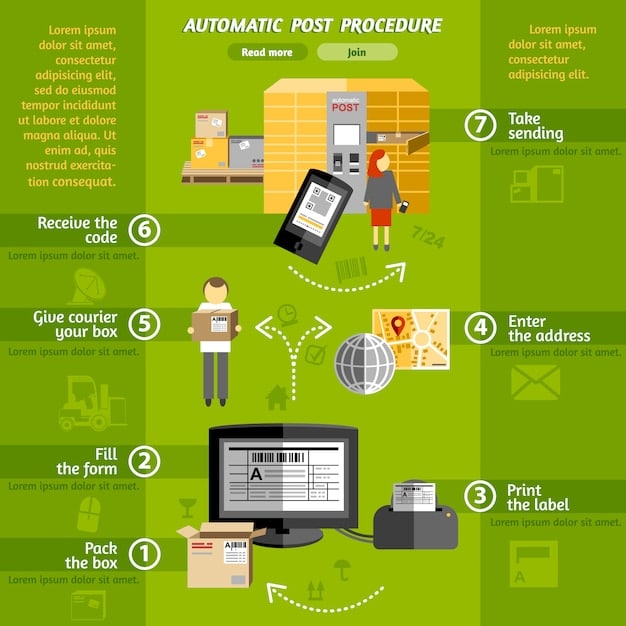E-commerce Platform Automation: Save 15 Hours Weekly in the US

E-commerce platform automation significantly enhances US e-commerce operations by streamlining tasks such as inventory management, order processing, and customer communication, potentially saving businesses up to 15 hours per week.
Is your US e-commerce business drowning in repetitive tasks? E-commerce platform automation: Streamlining your US e-commerce operations to save 15 hours per week can be a game-changer, freeing up valuable time and resources.
Understanding E-commerce Platform Automation
E-commerce platform automation involves using software and tools to automate repetitive tasks within your online store. This can range from simple tasks like sending automated email confirmations to more complex processes like inventory management and order fulfillment. Automation not only saves time but also reduces errors, improves efficiency, and enhances customer satisfaction.
What Tasks Can Be Automated?
A wide array of tasks can be automated within your e-commerce platform. Identifying these tasks is the first step toward streamlining your operations.
Benefits of E-commerce Automation
Implementing automation offers numerous advantages, contributing to both cost savings and increased revenue potential.
- Time Savings: Reduce the time spent on manual tasks, allowing your team to focus on strategic initiatives.
- Reduced Errors: Minimize human error in processes like order fulfillment and data entry.
- Improved Customer Satisfaction: Provide faster responses and more personalized experiences.
- Scalability: Easily handle increased order volumes and business growth without adding staff.
In conclusion, understanding the basics of e-commerce platform automation is crucial for any US-based e-commerce business looking to enhance efficiency and productivity. The potential to reclaim 15 hours per week should motivate businesses to explore automation solutions.
Choosing the Right E-commerce Platform for Automation
Selecting the right e-commerce platform is the foundation for successful automation. Not all platforms offer the same level of automation capabilities, and some are better suited for specific business needs. Consider factors like built-in automation features, integration options, and scalability when making your decision.
Key Features to Look For
When evaluating e-commerce platforms, prioritize those with robust automation functionalities.
Popular E-commerce Platforms with Automation Capabilities
Several platforms stand out for their automation capabilities, each offering unique features and benefits.

- Shopify: Known for its user-friendly interface and extensive app store, Shopify offers numerous automation apps for tasks like abandoned cart recovery, email marketing, and inventory management.
- WooCommerce: A flexible, open-source platform that integrates seamlessly with WordPress. WooCommerce supports automation through various plugins, allowing for customization and control over automation processes.
- BigCommerce: Provides built-in automation features for tasks like reordering, customer segmentation, and personalized product recommendations. BigCommerce is ideal for businesses looking for a comprehensive, out-of-the-box solution.
In summary, choosing the right e-commerce platform is a critical step in leveraging automation to save time and improve efficiency. Evaluate platforms based on their automation capabilities, integration options, and suitability for your business needs.
Implementing Automation: Step-by-Step Guide
Implementing automation in your e-commerce business requires a strategic approach. Start by identifying the specific tasks that can be automated, selecting the right tools and technologies, and developing a clear implementation plan. Proper implementation ensures a smooth transition and maximizes the benefits of automation.
Identifying Automation Opportunities
The first step is to identify areas where automation can have the most impact.
Selecting Automation Tools
Choosing the right tools is crucial for successful implementation.

- Email Marketing Automation: Tools like Mailchimp and Klaviyo can automate email campaigns, segment audiences, and personalize messaging.
- Inventory Management Systems: Software such as Fishbowl and Zoho Inventory automate inventory tracking, reordering, and stock level alerts.
- Order Fulfillment Automation: Solutions like ShipStation and Easyship streamline order processing, label printing, and shipping logistics.
In conclusion, a well-planned and executed automation strategy can transform your e-commerce business. By identifying opportunities, selecting the right tools, and following a structured approach, you can unlock significant time savings and efficiency gains.
Optimizing Your E-commerce Automation
Once automation is implemented, continuous optimization is key to maximizing its effectiveness. Regularly monitor performance metrics, gather feedback from your team, and make adjustments as needed. Optimization ensures that your automation efforts continue to deliver the desired results over time.
Monitoring Key Performance Indicators (KPIs)
Tracking KPIs provides insights into the effectiveness of your automation strategies.
Common Pitfalls to Avoid
Avoiding common mistakes can prevent setbacks and ensure a smooth automation journey.
Optimizing e-commerce automation is an ongoing process. By monitoring KPIs, avoiding common pitfalls, and adapting to changing business needs, you can ensure that your automation efforts continue to deliver value and drive growth.
Advanced Automation Techniques for E-commerce
Taking automation to the next level involves exploring advanced techniques that can further streamline your e-commerce operations. Techniques like AI-powered personalization, predictive analytics, and chatbot integration can enhance customer experiences and drive sales.
AI-Powered Personalization
Using AI to personalize the shopping experience can significantly increase engagement and conversions.
Chatbot Integration for Customer Service
Implementing chatbots can automate customer service inquiries and provide instant support.
In conclusion, embracing advanced automation techniques can set your e-commerce business apart from the competition. By leveraging AI, predictive analytics, and chatbots, you can create more personalized and efficient customer experiences.
Measuring the ROI of E-commerce Automation
Understanding the return on investment (ROI) of your e-commerce automation efforts is crucial for justifying the investment and demonstrating its value. Tracking key metrics like time savings, cost reductions, and revenue increases can provide a clear picture of the impact of automation on your business.
Calculating Time Savings
Quantifying time savings is a key component of measuring ROI.
Analyzing Cost Reductions
Automation can lead to significant cost savings in various areas.
Measuring the ROI of e-commerce automation is essential for demonstrating its value and justifying the investment. By tracking time savings, cost reductions, and revenue increases, you can gain a clear understanding of the impact of automation on your business.
| Key Point | Brief Description |
|---|---|
| ⏱️ Time Savings | Automate repetitive tasks to save up to 15 hours per week. |
| ✅ Error Reduction | Minimize human error in order fulfillment and data entry. |
| 📈 Scalability | Handle increased order volumes without adding staff. |
| 🤝 Customer Satisfaction | Provide faster responses and personalized experiences. |
Frequently Asked Questions (FAQ)
▼
E-commerce platform automation involves using software and tools to automate repetitive tasks, such as order processing, inventory management, and customer communication, to improve efficiency and reduce manual labor.
▼
By automating tasks like email marketing, order fulfillment, and inventory tracking, businesses can significantly reduce the time spent on manual processes, potentially saving up to 15 hours per week.
▼
Platforms like Shopify, WooCommerce, and BigCommerce offer robust automation features through built-in tools and integrations with third-party apps, catering to various business needs.
▼
Key benefits include time savings, reduced errors, improved customer satisfaction, and increased scalability, all contributing to enhanced efficiency and revenue potential for e-commerce businesses.
▼
Measuring ROI involves tracking metrics such as time savings, cost reductions, and revenue increases to assess the overall impact and value of automation on your e-commerce business operations.
Conclusion
In conclusion, e-commerce platform automation offers US businesses a powerful way to streamline operations, save valuable time, and improve overall efficiency. By understanding the benefits, selecting the right tools, and implementing a strategic approach, businesses can unlock significant time and cost savings, ultimately driving growth and success.





